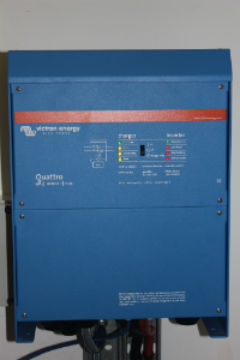Please note, this page has been archived and is no longer being updated.
Swansea University, in collaboration with two local renewable energy companies, is embarking on a major research project which aims to supply green energy to the Richard Burton Archives in the Library and Information Centre, Singleton Park campus.

Dr Gareth Blayney from Swansea University’s College of Engineering, in collaboration with The Sustainability Team at Swansea University and the University’s Information Services and Systems (ISS) have been working with local companies Gaia and Vindico, to design a comparison test exploring various new battery technologies using photovoltaic energy to generate solar power on the Library roof.
Photovoltaic (PV) is the method whereby solar energy is converted into direct current electricity, employing solar panels to supply usable solar power.
Dr Blayney said: “Although rooftop solar panels make energy cheaper and are more readily available, they do not generate energy during hours of darkness.
“With a resource as valuable as The Richard Burton Archives, it is essential that we have a system in place that provides continuous energy whilst also considering the economical and environmental cost.”
“What we have been looking at, together with Gaia Technologies and Vindico is the design of a comparison test to look at various new battery technologies using Photovoltaic (PV) generated power on the Library roof.
Ian Muxworthy, from Gaia Technologies said: “The PV panels on the roof will provide up to 24 kW of energy peak but the air conditioning unit will require a lot less than that so surplus energy will be used to charge the batteries. Once the sun goes down the batteries will take over and seamlessly provide power to the air conditioning.
“It is hoped that the system will provide enough power for 24/7 operation. Should the batteries go flat before daylight however, we have a fall-back position whereby the grid will take over. We have used three different types of battery for comparison purposes and all the equipment is monitored to provide data for research.”
The aim is to install 96 panels in total on the Library roof with an individual peak output of 250W. The efficiency and performance of different types of battery will be monitored constantly by the Sustainable Product Engineering Centre for Innovation in Functional Coatings (SPECIFIC) projectled by staff from the Materials Research Centre within the College of Engineering and Tata Steel, and it is intended that real-time results will be available on the internet.
Dr Blayney said: “This is an exciting initiative, harnessing photovoltaic energy, the global use of which is predicted to exceed 500GW by 2019, with 5GW already being generated in the UK - enough to power 3.5 million homes.”
“This research will provide us with information as to the efficiency of the different battery types, by monitoring charging and discharging rates. The project is predicted to save a substantial £27,573 over five years with 12 tons per annum reduction in CO2 emissions, enough energy to power six homes every year.”
- Wednesday 9 September 2015 14.09 BST
- Wednesday 9 September 2015 14.08 BST
- Mari Hooson, Tel: 01792 513455
